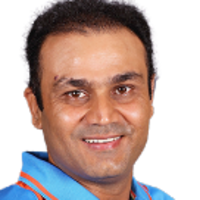|
|
|

Paul Collingwood hit a gutsy 108, but he was soon overshadowed by Virender Sehwag
© AFP
|
|
| |
For four days this Test has bubbled up and it finally burst into life on the fourth evening as Virender Sehwag pummelled an exhilarating 83, giving India an audacious start to chasing a daunting 387 for victory. Most of this match has been spent marvelling at the concentration of Andrew Strauss, who earlier in the day became the tenth England batsman to score twin hundreds but his innings, as well as Paul Collingwood's resolute 108, were quickly forgotten amid Sehwag's 68-ball onslaught. Rattled, the visitors were only calmed by a late Graeme Swann strike who trapped, crucially, Sehwag.
England didn't quite know what had hit them after Kevin Pietersen confidently declared on 311 for 9 - following a curiously negative afternoon session - as Sehwag and Gautam Gambhir added 117 in 22 overs. Even that marked a notable deceleration from the race-away start that saw the run-rate nudging double figures for the first few overs. The law of averages suggested India's top-order wouldn't suffer two consecutive collective failures and clear intent was shown to make up for their first innings failure. The target remains a long way off, but the final two hours have changed the feeling of the match.
The best crowd of the game found their voices and cheered each Sehwag boundary as if it was the winning stroke. Within the first five overs he crashed seven fours and a six, upper-cut over third man to send Pietersen scurrying for bowling changes: he had used his main five by the 15th over. To put Sehwag's barrage in context, England managed just eight fours in the 54 overs they faced on the fourth day.
Sehwag batted like a man possessed, refusing to let any bowler settle. He picked up two boundaries off James Anderson's first over, and was soon using Steve Harmison's natural pace and bounce to his advantage, although one flashing cut was palmed away by Alastair Cook when he was on 26. The problem is they come so quickly.
Monty Panesar was introduced in the sixth over and his third ball, a low full toss, Sehwag swung over deep square-leg. He was making a mockery of all talk of a crumbling pitch and he later followed that with a thumping straight six to leave Panesar flapping. He switched to over the wicket, a tactic that irked Sehwag and led to some discussion with Pietersen (presumably about negativity, a trait Sehwag clearly doesn't believe in) but at least it brought some relief for Panesar.
Once again, though, he was outbowled by the man playing his first Test. Swann ripped his first ball past Gambhir's outside edge and could have had the left-hander, but Daryl Harper failed to spot a small touch of the glove as the ball ballooned off pad. Sehwag too, was less comfortable - although everything is relative - against Swann's turn and was eventually undone by one that didn't bounce as much as expected. Sehwag walked off looking like a man cut off in his prime, but the effect he'd had on England was worth more than purely runs.
Not for the first time, Sehwag managed to bat like no one else - previously scoring had been all about careful accumulation. This is where Strauss excelled as he became the tenth England batsman, and first since Marcus Trescothick in 2004, to hit twin centuries in a Test. Sportsmen talk about being in the zone, and Strauss has been transfixed from the moment this match started. His second hundred came from 213 balls and was never anything other than perfectly controlled and composed.
Collingwood's seventh Test hundred was equally vital on a team and personal level. He was horribly scratchy in the one-day series, and received a rough decision in the first innings. But he put all those problems behind him with a 227-ball ton. Despite the chatter about Collingwood's form it is worth remembering this was his second hundred in three Tests, albeit five months apart, following a career-saving effort against South Africa at Edgbaston.
One of England's triumphs in this game has been the manner in which they neutralised Harbhajan Singh and he was again picked off as he bowled too short. Eventually though, he lured Strauss onto the front foot who drove a simple catch to extra cover to break a stand of 214. It is a mental picture Harbhajan would do well to carry north to Mohali - pitch the ball full to Strauss.
With a lead of 332, the situation was set for Andrew Flintoff, but he fell to the impressive Ishant Sharma. Two bouncers were followed by a good length ball outside off that shaped away and Flintoff pushed at it. Sharma enjoyed his mini-duel and Flintoff's departure meant the best chance of an onslaught disappeared. Zaheer Khan then collected three deserved wickets with late reverse swing.
England's innings didn't go very far at all during the afternoon session, with 57 runs coming in 22.5 overs. India tried every trick in the book to slow the over-rate, although by the end of the day England were probably the most grateful for nine overs that remained unbowled, allowing them to escape and take stock. Whatever the outcome of this Test, it has been an outstanding advert for the longer form of the game at a time when it was needed most.
Andrew McGlashan is a staff writer at Cricinfo


